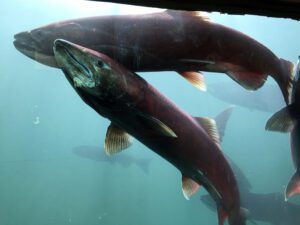
Scientists studying new information on changes in river discharge from winter ice melt and temperature in the Yukon River in Alaska say it may be influencing the timing and duration of juvenile chum, Chinook and coho salmon migrations.
They are trying to determine whether, as salmon migrations change, due to shifting environmental conditions, whether it leads to a mismatch with the availability of prey.
Katharine Miller, a fish biologist and lead author of the study, which was released on March 20, said the work is important in helping communities better understand what is behind recent declines in salmon abundance and how climate-induced environmental changes may alter migration patterns in future years.
The long-term decline of Chinook salmon along the Yukon River since the early 1990s resulted in the Alaska Department of Fish and Game (ADF&G) closing commercial and subsistence fisheries on the Yukon in 2011 and 2020. In addition, catastrophic declines in chum and coho salmon began in 2021 and have been closed to commercial and subsistence fishing ever since.
The study shows that high latitude rivers like the Yukon are warming at a rate nearly twice as rapid as more temperate areas.
For thousands of years indigenous people living along the banks of the Yukon River have depended on salmon for sustenance, as well as the role of these fish in cultural traditions, noted Courtney Weiss, co-author of the study and a research scientist with the Yukon Delta Fisheries Development Association.
Juvenile salmon migrating from freshwater to the ocean are in a critical period during which they undergo a lot of physical and behavioral changes, change influenced by environmental cues and river conditions, the study notes.
Juvenile salmon traveling the Yukon have some of the longest downstream migrations in the world, some of them traveling as far as 1,800 miles from freshwater in Canada before entering the Bering Sea. Once they reach the ocean, some salmon stay there several years before returning to their natal streams.
Their survival is higher when the river outmigration coincides with optimal ocean prey and environmental conditions.
Between 2014 and 2019 and in 2021, scientists measured and released over 75,000 juvenile salmon on the three main tributaries of the lower Yukon River. Over 91% of those fish were juvenile chum, 5.1 % were Chinook and 3.4% were coho.
The juvenile Chinooks’ migration was most closely correlated with the maximum river discharge, which occurred in June.
The study notes that seasonally migratory species like salmon can adjust their migration timing in response to altered discharge and temperatures, but at the same time changes in migration timing may result in mismatches between migrants and suitable ocean conditions or prey availability.
Miller said that now that scientists have a better idea of when environmental factors are most important to the migration processes, they will be evaluating what that means in term of prey availability and ocean conditions at the time salmon enter the ocean.
“This is really just the beginning of important work that needs to be done,” she said.
